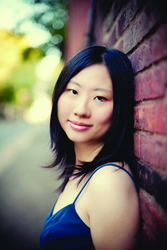We lead a busy chamber music life in Asheville. In addition to Asheville Chamber Music (which brings in world famous groups for five concerts each season), the city has three impresarios who regularly present chamber music, using mostly local musicians with an occasional visitor from afar. These are Ron Lambe with his long-standing St. Matthias Episcopal Church series, Kate Steinbeck now operating as Pan Harmonia, and Daniel Weiser with his relatively new AmiciMusic. AmiciMusic has put the “chamber” back in “chamber music” with its “house concerts” while both AmiciMusic and Pan Harmonia regularly use two new informal performance spaces: White Horse Black Mountain and the Altamont Theatre. The intimacy of the spaces, both of which are set up as cabarets, enhances the performances.
Pan Harmonia has recently established a regular series of chamber concerts at the Altamont called “2nd Sundays @ 5.” The April concert in this series was a solo recital by pianist Kimberly Cann that attracted eighty people, almost filling the Altamont.
The program opened with “Prelude and Caprice” by George Walker. Like Ms. Cann, Walker is a graduate of Eastman School of Music and has historical connections to the Caribbean, but they are hardly contemporaries. Walker composed “Prelude and Caprice” more than 65 years ago, early in a career that included many years of teaching composition as a university professor and culminated in a Pulitzer Prize about the time of his retirement. The composition is lyrical and neoclassical, reminding one of Howard Hanson who was likely a strong influence on the young Walker.
I won’t say much about the three Chopin pieces that rounded out the first half of this program. The two etudes were well played but not very exciting, and I was disappointed when the Barcarolle (Op. 60), which should have been a high point of the program, seemed detached and distant. I took consolation in two memories: hearing Ms. Cann play Chopin much better in other appearances, and hearing Isaac Stern play a profoundly mediocre Brahms Violin Concerto, showing that even the best of musicians is not always on top of the game. Live performance is a risky business.
The second half of the program provided redemption. Debussy’s “L’Isle Joyeuse” was a true harbinger of spring (the theme of the recital). Ms. Cann gave us vivacious voicings and subtle colorations, and towards the end of the piece her radiant smile matched the joy that her music was portraying. The final piece on the program was Ferruccio Busoni’s arrangement for piano of J.S. Bach’s Chaconne in D minor (S.1004).
Bach-Busoni transcriptions were commonly performed during my childhood, but fell out of favor with the gurus who dictate musical taste. After being ignored and disrespected for a few decades, these transcriptions have returned to favor in recent years. Busoni didn’t improve on Bach, but he showed genius in taking the solo violin Chaconne (a theme and 29 variations above a ground bass) and creating a brilliant piece for piano. Ms. Cann’s performance displayed the variety of ways that Busoni provided modulation – in rhythm, in articulation, in intensity, in tempo – so that the repetitive ground bass seems forever new and vigorous. In my book, this was the pièce de resistance of the concert. We left the Altamont with a vigorous spring in our step. Perhaps that was the “spring” that was the concert’s theme?
Check our calendar for future concerts under Pan Harmonia’s auspices.











